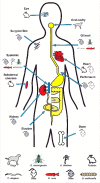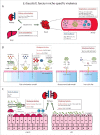Model systems for the study of Enterococcal colonization and infection
- PMID: 28102784
- PMCID: PMC5810481
- DOI: 10.1080/21505594.2017.1279766
Model systems for the study of Enterococcal colonization and infection
Abstract
Enterococcus faecalis and Enterococcus faecium are common inhabitants of the human gastrointestinal tract, as well as frequent opportunistic pathogens. Enterococci cause a range of infections including, most frequently, infections of the urinary tract, catheterized urinary tract, bloodstream, wounds and surgical sites, and heart valves in endocarditis. Enterococcal infections are often biofilm-associated, polymicrobial in nature, and resistant to antibiotics of last resort. Understanding Enterococcal mechanisms of colonization and pathogenesis are important for identifying new ways to manage and intervene with these infections. We review vertebrate and invertebrate model systems applied to study the most common E. faecalis and E. faecium infections, with emphasis on recent findings examining Enterococcal-host interactions using these models. We discuss strengths and shortcomings of each model, propose future animal models not yet applied to study mono- and polymicrobial infections involving E. faecalis and E. faecium, and comment on the significance of anti-virulence strategies derived from a fundamental understanding of host-pathogen interactions in model systems.
Keywords: Enterococcus faecalis; Enterococcus faecium; animal models; model hosts; polymicrobial infection; virulence factors.
Figures




Similar articles
-
Mature biofilms of Enterococcus faecalis and Enterococcus faecium are highly resistant to antibiotics.Diagn Microbiol Infect Dis. 2016 Jan;84(1):19-21. doi: 10.1016/j.diagmicrobio.2015.09.012. Epub 2015 Sep 18. Diagn Microbiol Infect Dis. 2016. PMID: 26458279
-
In Vivo and In Vitro Effects of a ClpP-Activating Antibiotic against Vancomycin-Resistant Enterococci.Antimicrob Agents Chemother. 2018 Jul 27;62(8):e00424-18. doi: 10.1128/AAC.00424-18. Print 2018 Aug. Antimicrob Agents Chemother. 2018. PMID: 29784838 Free PMC article.
-
Metabolic interplay between Proteus mirabilis and Enterococcus faecalis facilitates polymicrobial biofilm formation and invasive disease.mBio. 2024 Dec 11;15(12):e0216424. doi: 10.1128/mbio.02164-24. Epub 2024 Oct 30. mBio. 2024. PMID: 39475232 Free PMC article.
-
Optimizing future treatment of enterococcal infections: attacking the biofilm?Trends Microbiol. 2012 Jan;20(1):40-9. doi: 10.1016/j.tim.2011.11.001. Epub 2011 Dec 12. Trends Microbiol. 2012. PMID: 22169461 Review.
-
Glycopeptide-resistant enterococci: deciphering virulence, resistance and epidemicity.Curr Opin Infect Dis. 2007 Aug;20(4):384-90. doi: 10.1097/QCO.0b013e32818be63d. Curr Opin Infect Dis. 2007. PMID: 17609597 Review.
Cited by
-
Epidemiological profiles and pathogenicity of Vancomycin-resistant Enterococcus faecium clinical isolates in Taiwan.PeerJ. 2023 Feb 23;11:e14859. doi: 10.7717/peerj.14859. eCollection 2023. PeerJ. 2023. PMID: 36855433 Free PMC article.
-
Arginine impacts aggregation, biofilm formation, and antibiotic susceptibility in Enterococcus faecalis.FEMS Microbes. 2024 Sep 25;5:xtae030. doi: 10.1093/femsmc/xtae030. eCollection 2024. FEMS Microbes. 2024. PMID: 39524554 Free PMC article.
-
Complete Structure of the Enterococcal Polysaccharide Antigen (EPA) of Vancomycin-Resistant Enterococcus faecalis V583 Reveals that EPA Decorations Are Teichoic Acids Covalently Linked to a Rhamnopolysaccharide Backbone.mBio. 2020 Apr 28;11(2):e00277-20. doi: 10.1128/mBio.00277-20. mBio. 2020. PMID: 32345640 Free PMC article.
-
Native Infective Endocarditis: A State-of-the-Art-Review.Microorganisms. 2024 Jul 19;12(7):1481. doi: 10.3390/microorganisms12071481. Microorganisms. 2024. PMID: 39065249 Free PMC article. Review.
-
Enterococcal biofilm-A nidus for antibiotic resistance transfer?J Appl Microbiol. 2022 May;132(5):3444-3460. doi: 10.1111/jam.15441. Epub 2022 Jan 26. J Appl Microbiol. 2022. PMID: 34990042 Free PMC article. Review.
References
-
- Lebreton F, Willems RJL, Gilmore MS. Enterococcus diversity, origins in nature, and gut colonization In: Gilmore MS, Clewell DB, Ike Y, Shankar N, eds. Enterococci: From commensals to leading causes of drug resistant infection. Boston, 2014 - PubMed
-
- Weiner LM, Webb AK, Limbago B, Dudeck MA, Patel J, Kallen AJ, Edwards JR, Sievert DM. Antimicrobial-Resistant Pathogens Associated With Healthcare-Associated Infections: Summary of Data Reported to the National Healthcare Safety Network at the Centers for Disease Control and Prevention, 2011-2014. Infect Control Hosp Epidemiol 2016; 37(11):1288-301 - PMC - PubMed
-
- Frank KL, Vergidis P, Brinkman CL, Greenwood Quaintance KE, Barnes AM, Mandrekar JN, Schlievert PM, Dunny GM, Patel R. Evaluation of the Enterococcus faecalis biofilm-associated virulence factors AhrC and Eep in rat foreign body osteomyelitis and in vitro biofilm-associated antimicrobial resistance. PLoS One 2015; 10:e0130187; PMID:26076451; https://doi.org/10.1371/journal.pone.0130187 - DOI - PMC - PubMed
-
- Garsin DA, Frank KL, Silanpaa J, Ausubel FM, Hartke A, Shankar N, Murray BE. Pathogenesis and models of Enterococcal infection In: Gilmore MS, Clewell DB, Ike Y, Shankar N, eds. Enterococci: From commensals to leading causes of drug resistant infection. Boston, 2014 - PubMed
-
- Jett BD, Huycke MM, Gilmore MS. Virulence of Enterococci. Clinical microbiology reviews 1994; 7:462-78; PMID:7834601; https://doi.org/10.1128/CMR.7.4.462 - DOI - PMC - PubMed
Publication types
MeSH terms
Substances
LinkOut - more resources
Full Text Sources
Other Literature Sources
